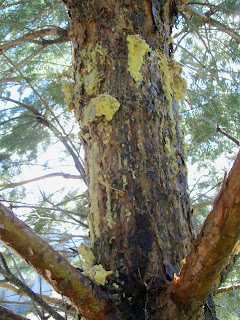Zimmerman Moth
If you have a Pinion Pine tree or an Austrian Pine tree, look for these signs of the Zimmerman Pine Moth.
Problem. Masses of pitch(sap) accumulate on the trunk near a whorl of branches. The trunk may be swollen above the masses and shrunken below them, Tops and branch tips may wilt and droop to resemble a shepherd's crick, then turn brown and die. Trees are stunted and deformed.
Analysis: The Zimmerman pine moth (Dioryctria zimmermani) is a serious pest of pines in the North-Central states. It attacks most pine trees and Douglas fir. Adults lay eggs in midsummer close to wounds on pine trees. Worms that hatch from these eggs immediately crawl under loose bark and hibernate until spring. As the new growth begins to expand the following spring, the larvae feed inside the tops of small trees and the branch tips of larger trees, causing the characteristic "shepherd's crook." In the late spring, they leave these shoots and crawl to the trunk, where they tunnel into the trunk to feed on the inner bark. Their tumbling causes the swelling and pitch masses where they feed. In midsummer, they pupate and emerge as adult moths.
Solution: Prune and destroy shepherd's crooks as soon as they are discovered to destroy the worms inside them. In midsummer, spray with neem oil. Wet the bark thoroughly to reach the newly hatched worms hiding under loose bark. In the spring,, spray again to kill the worms as they crawl across the bark to enter shoots.
Utah locations found to have Zimmerman Moths by Master Arbor so far, have been the following:
Cedar City
Pine Valley town
Dammeron Valley
Veyo
New Harmony
Call us for consultation or to treat the trees.




